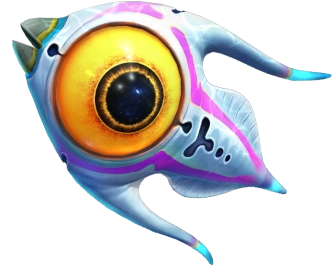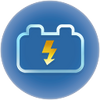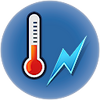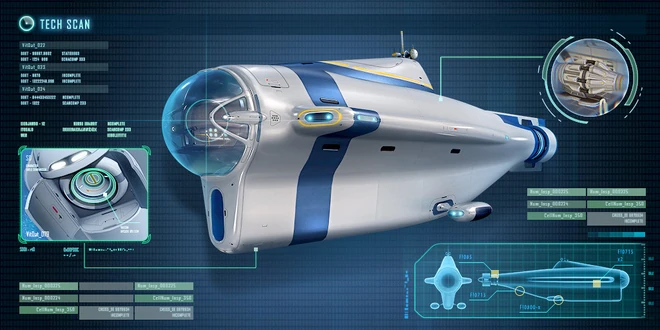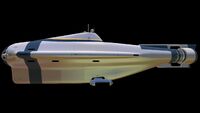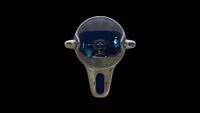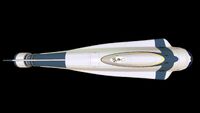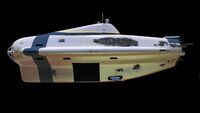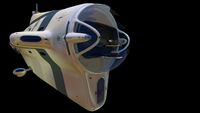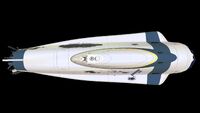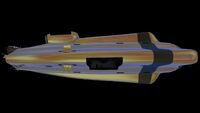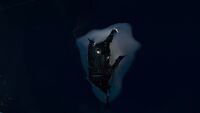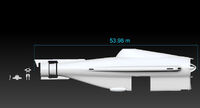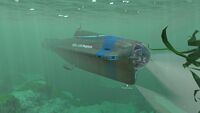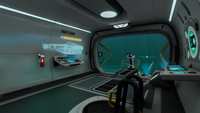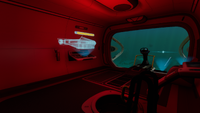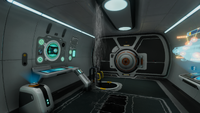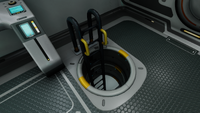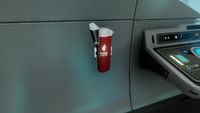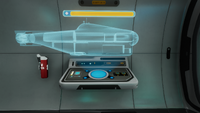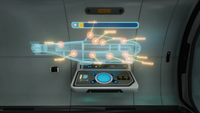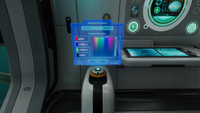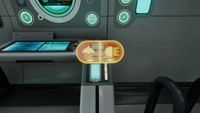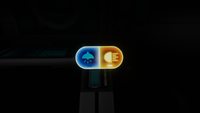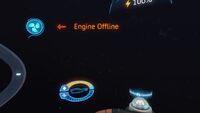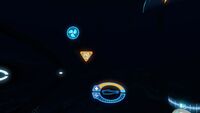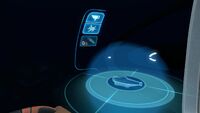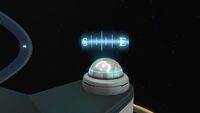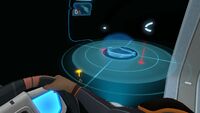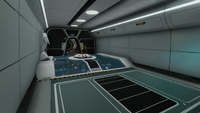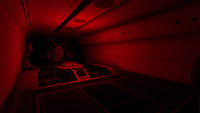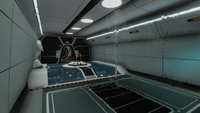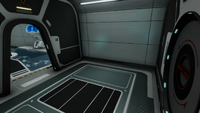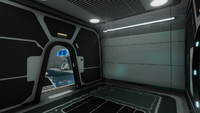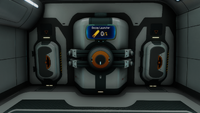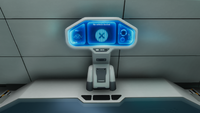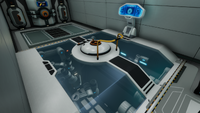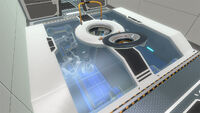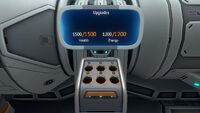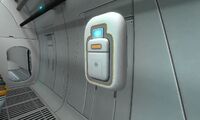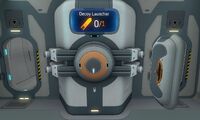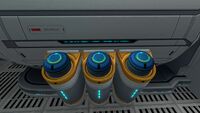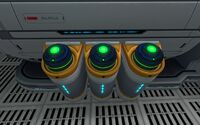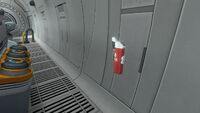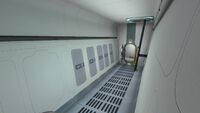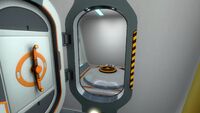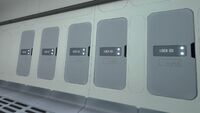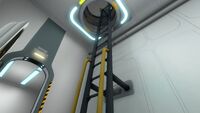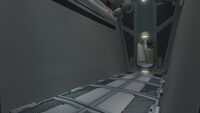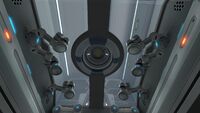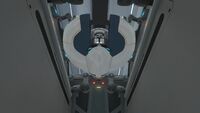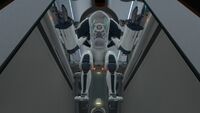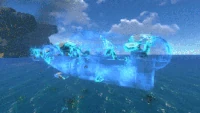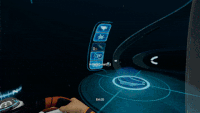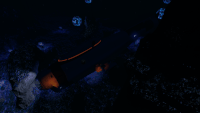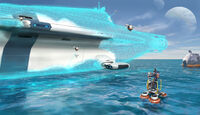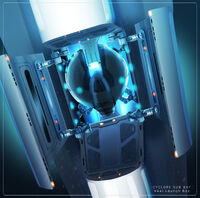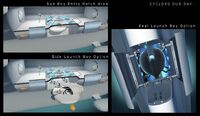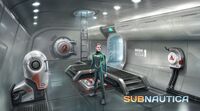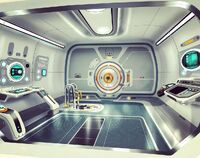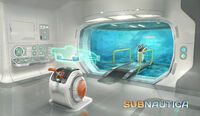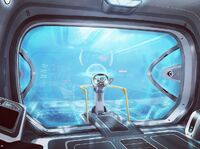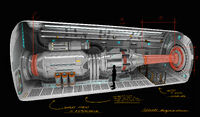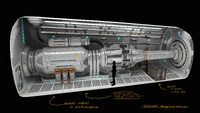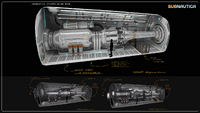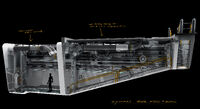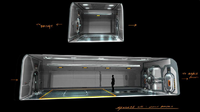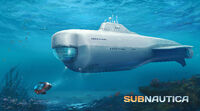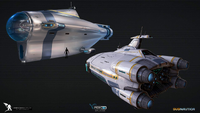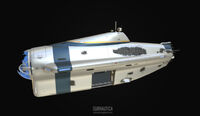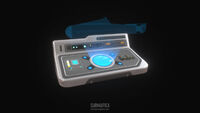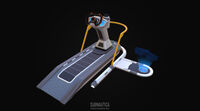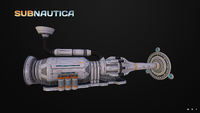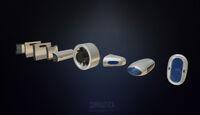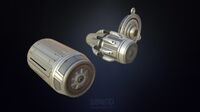
|
Read at own risk This article contains unmarked spoilers. Players new to the game would want to avoid or be cautious toward this article. |
The Cyclops is a player-controlled submarine that is constructed using the Mobile Vehicle Bay. It is equipped with a vehicle bay capable of storing a Seamoth or Prawn Suit and can be modified with a range of different upgrades.
At 54 meters long, 12 meters wide and 14 meters tall, the Cyclops is the largest vehicle available and capable of diving to depths of 500 meters, or 1700 meters fully upgraded. It can be utilized as a mobile base, capable of being outfitted with furniture and other amenities using the Habitat Builder.
Overview[]
Access is obtained either via the dive chamber located at the bow of the keel or via the docking bay when piloting a Seamoth or Prawn Suit. It is equipped with an onboard AI that will warn the player of danger and a beacon allowing the player to locate it at a distance. If the player choose to build multiple Cyclops, each will have its own beacon.
Blueprints[]
Unlike most other blueprints, the player must find and scan three different sets of fragments in order to craft the Cyclops. These are:
- Cyclops Hull fragments (Mushroom Forest, Sea Treader's Path, East side of Mountain Island)
- Cyclops Engine fragments (Aurora, Crag Field, Crash Zone, Mountains, and the Underwater Islands Wreck, East side of Mountain Island)
- Cyclops Bridge fragments (Crash Zone, Mushroom Forest and Sea Treader's Path, East side of Mountain Island)
Each set requires three fragments to be scanned to complete the component. Each component is shown individually in the PDA. Each completed component will progress the overall Cyclops blueprint by 33%; to fully complete the Cyclops blueprint, the player needs to locate and scan nine fragments in total. It should be noted that while the East side of Mountain Island is a viable place to find many, if not all of the parts, a Reaper Leviathan and numerous Boneshark patrols the area, and the parts reside at a depth of below 200m. A far safer option for finding all hull and bridge blueprints could be either of the Mushroom Forests, and engine fragments can be found with relative ease in the Crag Field.
Features[]
The Cyclops functions as a cross between a Seabase and a vehicle: the player can freely walk around inside it, only controlling it when they approach the helm control and "use" it. While controlling the helm, the player is still able to move their viewpoint in a limited arc to look around. The Cyclops takes over the movement controls, with forward and back moving the submarine in that direction, swim up and swim down being used to ascend and descend, and left and right used to turn. It cannot "strafe" sideways, nor can it pitch forward or back as the Seamoth can.
The submarine is equipped with three external cameras which are operated via the HUD. These cameras are located on the keel, sail and screw, which in layman's terms are below, above and at the rear of the submarine, respectively.
The Cyclops has three speed settings: "slow," "standard" and "flank." As well as speed, each setting affects the amount of noise generated and, in turn, the attention drawn from hostile fauna. More information on noise can be found in the Noise subsection.
A Cyclops is built with a full set of six standard Power Cells inserted into racks of three sockets on either side of the engine, and two wall-mounted Fire Extinguishers, one located next to the damage control console and the other in the engine room. If the player takes one of these, they can replace it (or place a different fire extinguisher) by equipping the extinguisher and looking at the wall bracket, which will bring up a "replace fire extinguisher" button prompt.
The Bridge is located at the bow of vessel and features a large domed glass port which is the primary viewing port for navigating.
A wall-mounted fire extinguisher can be located on the port wall and the player is able to access both the Upper midsection via a large bulkhead door and the keel via a dedicated ladder.
There are several different HUDs located here.
The middle of the HUD area is largely clear, but much of the HUD available to the pilot is not visible until the player engages the controls. The Cyclops is incapable of movement if the engine is disabled, and will display "Engine off" in red on the HUD to remind the player.
- Depth Indicator & Engine Power - Displayed at the top-center of the window, these values indicate the Cyclops' current/maximum depth, and the engine's remaining power (as a percentage).
- Compass - Displayed at the bottom of the window, attached to the top of the steering controls.
- Engine Power & Propeller Speed - Displayed on the upper-left of the window, the propeller icon toggles the engine on or off. Below it, players can select one of three speed settings. However, these speed settings are only visible on the HUD if the engine is turned on.
- Cyclops Health and Noise Emissions - Displayed as two bars on the lower-left of the window. Creature attacks and fire warnings will show here; The creature attack warning showing a yellow triangle with an icon of a mouth and 2 eyes and the fire warning showing a red triangle with the icon of a fire.
- External Cameras & Silent-Running Mode - Displayed on the right side of the window, these buttons allow the player to look through the external cameras, toggle Silent Running mode and activate the Decoy Launcher, as well as showing how many decoys are loaded. Other active Cyclops modules such as the Cyclops Shield Generator and Cyclops Sonar Upgrade will add icons to this panel, allowing the player to toggle them on or off.
- Clicking the camera icon will allow the player to cycle between the external cameras. There are three in total; one under the keel, one behind the propeller and one on the sail. These cameras are best used for navigating around obstacles and for checking for predators. The player is still fully in control of the Cyclops while using the cameras. The cameras have their own directional light, though these are only active when the camera is in use.
- Threat Indicator - A projector to the right of the helm displays a hologram of the Cyclops, the locations of nearby hostile creatures and the scope of the noise emitted, represented by a faint blue sphere. Hostile creatures appear as red triangles if they are likely to attack the Cyclops, and yellow triangles if they are not yet aware of it. Decoys appear as yellow dots.
- Proximity Indicator - If any part of the Cyclops is close to terrain, a warning icon of the Cyclops viewed from above will appear in the center of the HUD, with flashing red dots showing where the terrain is relative to the Cyclops' hull.
- Floodlights - Right-clicking while piloting the submarine will toggle the front-facing floodlights on and off, unless the vessel is rigged for silent running.
The starboard HUD offers several more controls.
- External Color Scheme and Custom Name - Players can use the panel on the left side of this HUD to customize the color scheme of the Cyclops' exterior and set a custom name of up to 14 characters for the Cyclops. The Cyclops' name will be displayed on its exterior starboard side and on its beacon.
- Internal Lights and Floodlights - Players can use the panel on the right side of this HUD to toggle the exterior front-facing floodlights and internal lights on or off. Both sets of lights can not be toggled on if Silent Running mode is activated.
The upper midsection of the vessel grants access to the Bridge via a single large circular airlock, and to the port and starboard sides of the engine room via two bulkhead doors.
The access port to the vehicle bay is located in the center of the large room and allows the player to disembark via a docked Seamoth or Prawn Suit.
A console is also located in this room, which allows the player to manage upgrade modules and access any storage on a docked vehicle. The health and energy of the vehicle can also be viewed on this console.
In between the two engine room doors is the loading port for the Decoy Tube. One Creature Decoy can be loaded here, or five if the Cyclops Decoy Tube Upgrade is installed.
This section is the largest open space on board. Thus it is a good place for the player to place large stationary items such as Fabricators, Lockers, or Indoor Growbeds.
The engine room is located at the stern of the vessel. The engine takes up almost all of the space in the room, leaving only a narrow passageway on either side for the player to walk down.
This is where the Cyclops' six Power Cells are located, three on either side of the engine. The player can check the charge status of each Power Cell and remove or replace them with LMB.
The Cyclops' upgrade fabricator is located on the starboard hull. It functions similarly to the upgrade fabricator in the Vehicle Upgrade Console and Scanner Room, allowing the player to craft dedicated Cyclops Upgrade Modules, which can be installed at the upgrade console located in the port side of the engine.
A wall-mounted fire extinguisher can be found on the port outer wall.
The player can dock a Seamoth or Prawn Suit within the Cyclops by approaching the middle of the keel, similar to the Moonpool. There is only space for one vehicle to be docked at a time.
Seamoths and Prawns will recharge while docked, draining power from the Cyclops' power cells. Vehicles in the Cyclops will also be repaired automatically if the Cyclops is equipped with a Cyclops Docking Bay Repair Module.
The Vehicle Bay can be accessed via the Aft Section or the Keel Section, allowing the player to observe any Docked Vehicles. The doors from the lower section into the Aft Section and Keel Section automatically close upon docking or undocking VehiclesThe keel section of the Cyclops has five built-in Storage Lockers, each containing 18 (3×6) units of space. The diving chamber is located here, which allows the player to embark and disembark from the vessel through a hatch.
The Aft Section is located beneath the Engine room, and serves as an access route between the Engine room and the Vehicle Bay. It has a small amount of room on the walls for smaller wall mounted objects like Wall Lockers and Fabricators.
Construction Recipe[]
Upgrades and Customization[]
The Cyclops can be customized using the onboard Cyclops Upgrade Fabricator located on the starboard side of the engine room.
Upgrades can be installed and removed via a six-slot panel on the port side of the engine room.
The Engine Efficiency Module and Decoy Tube Upgrade are first unlocked after building a Cyclops for the first time, but the Engine Efficiency Module can be acquired by grabbing the upgrade from the modification storage in the drive core room of the Aurora.
|
Increases the vehicle's maximum crush depth, enabling it to survive greater pressure. Each successive module increases the crush depth by 400 meters. This effect does not stack.
| |||||||||||||||||
|
Increases maximum battery life by recycling engine thermal waste and increases engine efficiency to 300%, decreasing engine power consumption to one third of its normal rate. This effect doesn't stack. Recipe: | |||||||||||||||||
|
Replenishes the onboard power supply by harnessing thermal energy in areas with an ambient temperature greater than 30ºC. The charge rate depends on the amount of heat in the surrounding environment, and reaches the maximum at 60°C. This effect doesn't stack. Recipe:
| |||||||||||||||||
|
Emits a sonic wave that reads the topography of the surrounding terrain and displays the data on the HUD. Recipe: | |||||||||||||||||
|
Automatically extinguishes any fires that result from incoming damage, preserving the majority of the vehicle's hull integrity. Recipe: | |||||||||||||||||
|
Automatically repairs any Seamoth or Prawn Suit inside the docking bay. Recipe: | |||||||||||||||||
|
Increases the maximum number of decoys that the launch tube can hold by four, from one to five. This effect does not stack. Recipe: | |||||||||||||||||
|
Temporarily projects an electromagnetic shield around the submarine, repelling hostile or troublesome fauna and negating all incoming damage. Recipe: |
Energy[]
The Cyclops is powered via power cells and can have up to six installed; standard power cells allow for a total of 1200 units of energy. The individual cells are drained sequentially during use.
|
Spoiler alert: The following section contains story related material. |
|---|
|
Ion Power Cells can also be placed into the six slots, supplying a total of 6000 energy. |
The Cyclops' engine consumes energy when moving or turning, but not when stationary. The Silent Running, Shield Generator, Sonar, and any placeable items that require an external power source will also consume the Cyclops' energy. The different speed settings (Slow, Standard, and Flank) affect the rate of energy consumption, which can be found below:
| Speed Setting | Energy Consumption Rate (⚡/Min) | Acceleration (Meters/Sec²) | Top speed (Meters/Sec) | Efficiency (Meters/⚡) | Noise reach (Meters) |
|---|---|---|---|---|---|
| Ahead Slow | 4.5 ⚡/min | 4.7 m/s² | 6.7 m/s | 88.9 m/⚡ | 82.5 m |
| Ahead Standard | 9.9 ⚡/min | 6.3 m/s² | 8.9 m/s | 53.9 m/⚡ | 105 m |
| Ahead Flank | 19.8 ⚡/min | 7.3 m/s² | 10.4 m/s | 31.5 m/⚡ | 150 m |
| Speed Setting | Energy Consumption Rate (⚡/Min) | Acceleration (Meters/Sec²) | Top speed (Meters/Sec) | Efficiency (Meters/⚡) | Noise reach (Meters) |
|---|---|---|---|---|---|
| Ahead Slow | 604.5 ⚡/min | 4.7 m/s² | 6.7 m/s | 0.7 m/⚡ | 82.5 m |
| Ahead Standard | 609.9 ⚡/min | 6.3 m/s² | 8.9 m/s | 0.9 m/⚡ | 105 m |
| Ahead Flank | 619.8 ⚡/min | 7.3 m/s² | 10.4 m/s | 1.0 m/⚡ | 150 m |
| Speed Setting | Energy Consumption Rate (⚡/Min) | Acceleration (Meters/Sec²) | Top speed (Meters/Sec) | Efficiency (Meters/⚡) | Noise reach (Meters) |
|---|---|---|---|---|---|
| Ahead Slow | 124.5 ⚡/min | 4.7 m/s² | 6.7 m/s | 3.2 m/⚡ | 82.5 m |
| Ahead Standard | 129.9 ⚡/min | 6.3 m/s² | 8.9 m/s | 4.1 m/⚡ | 105 m |
| Ahead Flank | 139.8 ⚡/min | 7.3 m/s² | 10.4 m/s | 4.5 m/⚡ | 150 m |
| Speed Setting | Energy Consumption Rate (⚡/Min) | Acceleration (Meters/Sec²) | Top speed (Meters/Sec) | Efficiency (Meters/⚡) | Noise reach (Meters) |
|---|---|---|---|---|---|
| Ahead Slow | 724.5 ⚡/min | 4.7 m/s² | 6.7 m/s | 0.6 m/⚡ | 82.5 m |
| Ahead Standard | 729.9 ⚡/min | 6.3 m/s² | 8.9 m/s | 0.7 m/⚡ | 105 m |
| Ahead Flank | 739.8 ⚡/min | 7.3 m/s² | 10.4 m/s | 0.8 m/⚡ | 150 m |
| Speed Setting | Energy Consumption Rate (⚡/Min) | Acceleration (Meters/Sec²) | Top speed (Meters/Sec) | Efficiency (Meters/⚡) | Noise reach (Meters) |
|---|---|---|---|---|---|
| Ahead Slow | 1.5 ⚡/min | 4.7 m/s² | 6.7 m/s | 266.7 m/⚡ | 82.5 m |
| Ahead Standard | 3.3 ⚡/min | 6.3 m/s² | 8.9 m/s | 161.8 m/⚡ | 105 m |
| Ahead Flank | 6.6 ⚡/min | 7.3 m/s² | 10.4 m/s | 94.5 m/⚡ | 150 m |
| Speed Setting | Energy Consumption Rate (⚡/Min) | Acceleration (Meters/Sec²) | Top speed (Meters/Sec) | Efficiency (Meters/⚡) | Noise reach (Meters) |
|---|---|---|---|---|---|
| Ahead Slow | 601.5 ⚡/min | 4.7 m/s² | 6.7 m/s | 0.7 m/⚡ | 82.5 m |
| Ahead Standard | 603.3 ⚡/min | 6.3 m/s² | 8.9 m/s | 0.9 m/⚡ | 105 m |
| Ahead Flank | 606.6 ⚡/min | 7.3 m/s² | 10.4 m/s | 1.0 m/⚡ | 150 m |
| Speed Setting | Energy Consumption Rate (⚡/Min) | Acceleration (Meters/Sec²) | Top speed (Meters/Sec) | Efficiency (Meters/⚡) | Noise reach (Meters) |
|---|---|---|---|---|---|
| Ahead Slow | 121.5 ⚡/min | 4.7 m/s² | 6.7 m/s | 3.3 m/⚡ | 82.5 m |
| Ahead Standard | 123.3 ⚡/min | 6.3 m/s² | 8.9 m/s | 4.3 m/⚡ | 105 m |
| Ahead Flank | 126.6 ⚡/min | 7.3 m/s² | 10.4 m/s | 4.9 m/⚡ | 150 m |
| Speed Setting | Energy Consumption Rate (⚡/Min) | Acceleration (Meters/Sec²) | Top speed (Meters/Sec) | Efficiency (Meters/⚡) | Noise reach (Meters) |
|---|---|---|---|---|---|
| Ahead Slow | 721.5 ⚡/min | 4.7 m/s² | 6.7 m/s | 0.6 m/⚡ | 82.5 m |
| Ahead Standard | 723.3 ⚡/min | 6.3 m/s² | 8.9 m/s | 0.7 m/⚡ | 105 m |
| Ahead Flank | 726.6 ⚡/min | 7.3 m/s² | 10.4 m/s | 0.9 m/⚡ | 150 m |
| Speed Setting | Energy Consumption Rate (⚡/Min) | Acceleration (Meters/Sec²) | Top speed (Meters/Sec) | Efficiency (Meters/⚡) | Noise reach (Meters) |
|---|---|---|---|---|---|
| Ahead Slow | 64.5 ⚡/min | 4.7 m/s² | 6.7 m/s | 6.2 m/⚡ | 41.25 m |
| Ahead Standard | 69.9 ⚡/min | 6.3 m/s² | 8.9 m/s | 7.6 m/⚡ | 52.5 m |
| Ahead Flank | 79.8 ⚡/min | 7.3 m/s² | 10.4 m/s | 7.8 m/⚡ | 75 m |
| Speed Setting | Energy Consumption Rate (⚡/Min) | Acceleration (Meters/Sec²) | Top speed (Meters/Sec) | Efficiency (Meters/⚡) | Noise reach (Meters) |
|---|---|---|---|---|---|
| Ahead Slow | 664.5 ⚡/min | 4.7 m/s² | 6.7 m/s | 0.6 m/⚡ | 41.25 m |
| Ahead Standard | 669.9 ⚡/min | 6.3 m/s² | 8.9 m/s | 0.8 m/⚡ | 52.5 m |
| Ahead Flank | 679.8 ⚡/min | 7.3 m/s² | 10.4 m/s | 0.9 m/⚡ | 75 m |
| Speed Setting | Energy Consumption Rate (⚡/Min) | Acceleration (Meters/Sec²) | Top speed (Meters/Sec) | Efficiency (Meters/⚡) | Noise reach (Meters) |
|---|---|---|---|---|---|
| Ahead Slow | 184.5 ⚡/min | 4.7 m/s² | 6.7 m/s | 2.2 m/⚡ | 41.25 m |
| Ahead Standard | 189.9 ⚡/min | 6.3 m/s² | 8.9 m/s | 2.8 m/⚡ | 52.5 m |
| Ahead Flank | 199.8 ⚡/min | 7.3 m/s² | 10.4 m/s | 3.1 m/⚡ | 75 m |
| Speed Setting | Energy Consumption Rate (⚡/Min) | Acceleration (Meters/Sec²) | Top speed (Meters/Sec) | Efficiency (Meters/⚡) | Noise reach (Meters) |
|---|---|---|---|---|---|
| Ahead Slow | 784.5 ⚡/min | 4.7 m/s² | 6.7 m/s | 0.5 m/⚡ | 41.25 m |
| Ahead Standard | 789.9 ⚡/min | 6.3 m/s² | 8.9 m/s | 0.7 m/⚡ | 52.5 m |
| Ahead Flank | 799.8 ⚡/min | 7.3 m/s² | 10.4 m/s | 0.8 m/⚡ | 75 m |
| Speed Setting | Energy Consumption Rate (⚡/Min) | Acceleration (Meters/Sec²) | Top speed (Meters/Sec) | Efficiency (Meters/⚡) | Noise reach (Meters) |
|---|---|---|---|---|---|
| Ahead Slow | 21.5 ⚡/min | 4.7 m/s² | 6.7 m/s | 18.6 m/⚡ | 41.25 m |
| Ahead Standard | 23.3 ⚡/min | 6.3 m/s² | 8.9 m/s | 22.9 m/⚡ | 52.5 m |
| Ahead Flank | 26.6 ⚡/min | 7.3 m/s² | 10.4 m/s | 23.5 m/⚡ | 75 m |
| Speed Setting | Energy Consumption Rate (⚡/Min) | Acceleration (Meters/Sec²) | Top speed (Meters/Sec) | Efficiency (Meters/⚡) | Noise reach (Meters) |
|---|---|---|---|---|---|
| Ahead Slow | 621.5 ⚡/min | 4.7 m/s² | 6.7 m/s | 0.6 m/⚡ | 41.25 m |
| Ahead Standard | 623.3 ⚡/min | 6.3 m/s² | 8.9 m/s | 0.9 m/⚡ | 52.5 m |
| Ahead Flank | 626.6 ⚡/min | 7.3 m/s² | 10.4 m/s | 1.0 m/⚡ | 75 m |
| Speed Setting | Energy Consumption Rate (⚡/Min) | Acceleration (Meters/Sec²) | Top speed (Meters/Sec) | Efficiency (Meters/⚡) | Noise reach (Meters) |
|---|---|---|---|---|---|
| Ahead Slow | 141.5 ⚡/min | 4.7 m/s² | 6.7 m/s | 2.8 m/⚡ | 41.25 m |
| Ahead Standard | 143.3 ⚡/min | 6.3 m/s² | 8.9 m/s | 3.7 m/⚡ | 52.5 m |
| Ahead Flank | 146.6 ⚡/min | 7.3 m/s² | 10.4 m/s | 4.3 m/⚡ | 75 m |
| Speed Setting | Energy Consumption Rate (⚡/Min) | Acceleration (Meters/Sec²) | Top speed (Meters/Sec) | Efficiency (Meters/⚡) | Noise reach (Meters) |
|---|---|---|---|---|---|
| Ahead Slow | 741.5 ⚡/min | 4.7 m/s² | 6.7 m/s | 0.5 m/⚡ | 41.25 m |
| Ahead Standard | 743.3 ⚡/min | 6.3 m/s² | 8.9 m/s | 0.7 m/⚡ | 52.5 m |
| Ahead Flank | 746.6 ⚡/min | 7.3 m/s² | 10.4 m/s | 0.8 m/⚡ | 75 m |
Movement in multiple directions (moving forward while turning, or moving forward while turning and diving) will increase the rate at which energy is drained. The engine efficiency module increases efficiency by 300% when installed: the effect does not stack with multiple modules. The interior and exterior illumination does not consume energy. Exiting the vehicle will not disable the engine, and the lights will remain in whatever state the player left them in.
The Cyclops' power supply is also consumed if a Seamoth or Prawn Suit is recharging in the docking bay. They recharge at the same rate as if their power cell(s) were in a Power Cell Charger.
If the Cyclops runs out of power, the lights will turn off and the Cyclops will stop producing oxygen. The hatches will still function as normal, and a docked vehicle can exit the Cyclops as normal. The same is not true in reverse: a vehicle cannot dock with an unpowered Cyclops. The vehicle's horn also still functions when it is unpowered.
Fabrication and Appliances[]
The Cyclops can be further customized using placeable items constructed with the Habitat Builder. Any Fabricators, Modification Stations, Battery Chargers or Power Cell Chargers built in the Cyclops will draw from the power supply. Other items―such as Lockers, Aquariums and Interior Growbeds can also be placed, which can be very useful for growing and storing food and materials on Survival mode for long-term sustenance when away from a seabase for extended periods. Placeable cosmetics, such as the Lab Equipment, can also be placed inside the Cyclops. This includes in the lower section of the Vehicle Bay, however items placed on the wall there do not move when the bay opens, and are sometimes visible from outside. Placed items in the Vehicle Bay do not affect the ability to dock a Seamoth or Prawn Suit.
Interior Pieces, such as the Bioreactor or Water Filtration Machine cannot be placed inside of the Cyclops. In addition, the player cannot drop items from their inventory onto the floor inside the vehicle.
Appliances can be used even if the engine is disabled. Energy-consuming appliances cannot be used if the Cyclops' onboard energy supply is exhausted.
Damage and Destruction[]
A Cyclops has 1,500 hit points, which cannot be altered by any of its upgrades. These are subdivided into 300 hit points which form a regenerating "overshield," and 1,200 hit points which are associated with the Cyclops' hull.
The overshield absorbs all damage taken by the Cyclops when the submarine has more than 80% of its health and prevents hull damage while it is active. When the overshield has absorbed damage, it will deplete, but slowly recharge on its own as long as the hull is intact. The overshield is simply depicted as the top 20% of the Cyclops' health bar, with no special indication of what it is or where its cutoff point is.
Damage that exceeds the capacity of the overshield will cause one or more hull breaches. Hull breaches can only be repaired from the outside of the Cyclops using the Repair Tool. The hologram on the left side of the bridge will mark approximately where hull breaches are located: the player can check this display by looking in through the bow window while outside the vessel. Unlike other vehicles, the hull breaches must be repaired directly to restore the Cyclops' health: no part of the hull but a breach will show a repair progress icon.
If damage continues, fires will start in random locations and will spread if not extinguished. These fires will cause additional damage (if the player is on board), reduce visibility and damage the player's health due to suffocating smoke or direct contact with the flames. Small fires can sometimes burn out on their own, but they will usually require the use of the onboard Fire Extinguishers to bring them under control. If the Cyclops Fire Suppression System is equipped and activated, it will close and lock all bulkheads and a blue light will flash. A few seconds later, all fires will be extinguished and the smoke will evacuate. The Suppression System will need time to recharge before it can be used again (about two minutes).
Piloting a Cyclops at flank speed for more than 20 seconds will lead to the AI issuing a warning that the engine is overheating, after which there is a chance for a fire to start every 2 seconds. Fires from overusing flank speed will always occur in the engine room.
If the Cyclops reaches its current crush depth, the player will be alerted by the onboard AI stating, "WARNING: Maximum depth reached! Hull damage imminent!" As soon as this warning occurs, the submarine's health will begin to drop rapidly. The depth is judged from the horizontal centerline of the Cyclops' hull. The Cyclops Depth Module MK1, MK2 and MK3 upgrades allow the player to increase the crush depth from its default 500m to 900m, 1,300m and 1,700m respectively.
It should be noted that if a vehicle docked with a Cyclops has an inferior crush depth to the Cyclops itself, the vehicle will not be damaged while it is still docked with the Cyclops no matter how deep the latter goes.
If a Cyclops' health is totally depleted it will explode. The Cyclops' AI will warn the player before this explosion, providing time to exit the submarine. Upon explosion:
- If the player is on board at the time, they will be killed instantly.
- Any docked Seamoth or Prawn Suit will be destroyed instantly.
- A wreck will remain, which will have openings in the bridge, vehicle bay, and stern for access.
- Any placeable items, such as Fabricators, Power Cell Chargers and lockers, will remain and can be emptied/deconstructed.
- The contents of the built-in lockers, Power Cells in the engine room, and the upgrades panel will remain and can be retrieved, as can the fire extinguishers from their wall mounts.
- Power cells plugged into the engine will have their charge reduced to zero
- A small amount of Metal Salvage and Computer Chips will be scattered around the location.
- A Beacon will be deployed at the location of the wreck.
If the player uses the dev console command damagesub, the Cyclops will take 400 damage.
Noise[]
Noise will draw hostile creatures' attention to the Cyclops. The more noise the sub is generating, the greater the range from which aggressive creatures will be drawn to attack the sub. The amount of noise generated is dependent on several factors.
The different speed settings will cause the Cyclops to emit noise, with faster settings increasing the amount of noise. This is visualized on the sonar display on the right by a faint blue sphere. This blue sphere represents the area of water where creatures can hear the Cyclops: standard speed is about the size of the first circle permanently present on the sonar display, while flank speed is almost as big as the entire sonar. All hostile creatures that could damage the Cyclops are marked as yellow blips on the sonar. If the creature hears the Cyclops, the blip will turn red. If this occurs it can be prudent to either switch to flank speed and retreat, activate the Cyclops Shield Generator in anticipation of a collision, or eject a Creature Decoy and quiet the engines in the hope it will be distracted by the more obvious target.
The external floodlights do not affect the amount of noise the Cyclops generates, but cannot be on when Silent Running is active.
Activating Silent Running will suppress 50% of all noise being emitted by the sub until the player deactivates it. Silent Running drains one energy every second while it is active. This power drain is not affected by the Cyclops Engine Efficiency Module.
Disabling the engine or staying completely still with Silent Running on will stop the Cyclops from emitting noise completely. Silent Running will still drain power even if the engine is disabled. Even if the Cyclops is totally silent, a creature that sees the vehicle may still attack it.
Hostile Fauna[]
Most Fauna cannot damage a Cyclops, and the player is immune to the attention of Warpers while they are inside the vehicle. Medium-sized predators such as Bonesharks and Stalkers can attempt to attack a Cyclops, but will not inflict any damage. The latter may drop a Stalker Tooth in the attempt. Only the largest of predators present a threat to the vehicle: all of these will be flagged on the holographic display to the right of the helm as hostile contacts.
Lava Larvae are not flagged as hostile fauna in the hostile creature display and cannot physically damage the Cyclops, but will attach to the hull and leech power from its cells. The damage display will show the approximate location of any Larva attached to the Cyclops with a yellow "bug" icon: they can be removed by getting out and striking them with the Survival Knife or Thermoblade, using a Propulsion Cannon or any device with a similar effect, activating the Cyclops Shield Generator (simply flicking it on and off is enough) or removing all of the Cyclops' Power Cells. However, doing so will cause the Cyclops to stop producing oxygen, and an ill-equipped player could suffocate if they do not put the Power Cells back in time. It is possible to remove Lava Larva from the Cyclops by shooting them out from the inside with a Repulsion Cannon. This can cause objects inside the Cyclops to be launched as well.
When a creature is attacking a Cyclops, a whooping alarm will sound and the interior lighting will turn red for a short time, accompanied by the AI stating "Warning: Creature Attack!" In addition, a yellow triangular warning icon will flash on the health and noise status screen each time the Cyclops is attacked. This warning does not necessarily mean the Cyclops has sustained hull damage, only that it has been attacked by a creature capable of damaging it.
It is recommended to use features such as slower speeds, silent running, the Cyclops Shield Generator, and turn off exterior lights or the engine to avoid attacks. If necessary, creature decoys can be launched and the ahead flank or emergency speed option can be used to flee from attacking creatures.
The creatures below can and will attack the Cyclops if too much attention is drawn to it.
Audio[]
These tracks will only play if there is a fire onboard the Cyclops while the player is in the Cyclops.
Data Bank Entry[]
|
The cyclops is the most popular and reliable deep-sea submersible in the galaxy. By comparison to the competition it can be crewed by just one pilot, hence the name. It features: Advice for Captains: Ratings: NB The cyclops does NOT feature: |
Achievement[]
| Spoiler alert: The following section contains story related material.
| |

|
40-foot Sub For One Build a cyclops
|
Gallery[]
Bridge[]
Pilot HUD[]
Upper Midsection[]
Engine Room[]
Keel Section[]
Vehicle Bay[]
Trivia[]
- Sometimes, when entering the Cyclops, the AI will say "You are the best captain on this planet, I'm not even squidding." This is a reference to the player being the only human and pilot of a Cyclops on the planet, as well as being both a pun on "kidding" and a reference to real-life squids.
- During development, the Cyclops went through several iterations, many experimenting with how and when it took damage. For a long period it was completely invulnerable, then when damage was initially added back even medium-sized predators like Bonesharks could damage it.
- A model still exists in the cyclops today (although invisible) which was an upgrade console with 4 upgrade slots rather than the current 6. It was likely upgraded over time as more modules were planned to be added.
- Its in-game description references an older damage model where flooding was implemented: when damaged severely enough the Cyclops would sink and cease functioning until it was repaired.
- There used to be a "safe depth", above which the Cyclops would not take damage even from collisions. Crush depth on the other hand would cause damage automatically, and is still in the game.
- The player used to be able to place Solar Panels or even a Nuclear Reactor on top of the Cyclops: if this was done, the Cyclops would be powered by these instead of its Power Cells. The ability to construct base components on top of the vessel was later removed due to frequent physics glitches. Cory Strader also stated that the option for solar power was removed from the Cyclops as the team did not want to encourage the player to use the submarine near the surface.[1]
- The Cyclops requires the most scans of any item in the game before it can be crafted, excluding the unachievable 20 scan threshold for Prawn Suit fragments found outside the Aurora.
- Hostile fauna within an Alien Containment are marked on the Cyclops' threat detector hologram.
- The Cyclops shares its name with a real-life deep-sea submarine developed by a company called OceanGate, and the game acknowledges OceanGate's trademark on this name in the credits.
- Interestingly, the real-life Cyclops closely resembles an I Compartment with an endcap Window.
- OceanGate would later become infamous when, on June 18, 2023, OceanGate's Titan submersible (also known as the Cyclops 2 until 2018) would suffer a catastrophic implosion on a dive to explore the wreck of the Titanic. The implosion killed all five on board, including OceanGate founder Stockton Rush.
- There used to be different alarm sounds. The first version lasted until right before the Cyclops was properly added. Eventually it was replaced with a newer version during the Silent Running Update.
- It's possible to almost complete the game without ever building a Cyclops. However, completing the Neptune Escape Rocket does require ownership of a Cyclops, in order to use its onboard Upgrade Console to fabricate a Cyclops Shield Generator for the cockpit section.
Bugs[]
 When loading into a game where the player is inside a Cyclops that is partly above-water, walking around will result in swimming sounds incorrectly playing.
When loading into a game where the player is inside a Cyclops that is partly above-water, walking around will result in swimming sounds incorrectly playing.

 Certain translucent effects will incorrectly layer on top of the elements of the Cyclops HUD, including thermal plumes and brine in the lost river.
Certain translucent effects will incorrectly layer on top of the elements of the Cyclops HUD, including thermal plumes and brine in the lost river.

 If positioned just right on the waterline, the Cyclops' window can be used to see above the water before the sky is loaded in, resulting in a pure blue, cloudless appearance. This can only be seen out of the very top of the window.
If positioned just right on the waterline, the Cyclops' window can be used to see above the water before the sky is loaded in, resulting in a pure blue, cloudless appearance. This can only be seen out of the very top of the window. Rarely, if attempting to dive/surface while undocking, the Cyclops will be canted at an angle and will not level out (tested: leaving, entering, toggling engines, fully surfacing) this makes it almost impossible to navigate. Solved by saving and reloading.
Rarely, if attempting to dive/surface while undocking, the Cyclops will be canted at an angle and will not level out (tested: leaving, entering, toggling engines, fully surfacing) this makes it almost impossible to navigate. Solved by saving and reloading.

 When removing all Power Cells from the Cyclops in Creative, the power indicator while piloting the Cyclops will display the 32-bit-integer limit.
When removing all Power Cells from the Cyclops in Creative, the power indicator while piloting the Cyclops will display the 32-bit-integer limit.
 In Seabases, Lifepod 5, and the Cyclops, the boiling water effect from the Thermoblade while equipped underwater appears when inside the aforementioned locations.
In Seabases, Lifepod 5, and the Cyclops, the boiling water effect from the Thermoblade while equipped underwater appears when inside the aforementioned locations. There is a bug that happens when you load into the game, where a fish (mainly the edible prey fish) such as the Peeper or Spadefish will clip in through the Cyclops and is able to be picked up. The reason for this is unknown, but it could have something to do with the collision glitching out.
There is a bug that happens when you load into the game, where a fish (mainly the edible prey fish) such as the Peeper or Spadefish will clip in through the Cyclops and is able to be picked up. The reason for this is unknown, but it could have something to do with the collision glitching out. When putting a poster in your cyclops, the game sometimes doesn't register that it's in the cyclops. Driving away from the poster with this bug will cause the poster to float in the same position. You can tell that this bug is activated when the poster matches the lighting of the biome you're currently in. This can be fixed by picking up the poster, save/reload, and putting it back where you want it.
When putting a poster in your cyclops, the game sometimes doesn't register that it's in the cyclops. Driving away from the poster with this bug will cause the poster to float in the same position. You can tell that this bug is activated when the poster matches the lighting of the biome you're currently in. This can be fixed by picking up the poster, save/reload, and putting it back where you want it. When reloading into a game where the Seamoth is docked, and the vehicle hatch is closed, the Seamoth hatch may open, resulting in the two doors clipping into each other.
When reloading into a game where the Seamoth is docked, and the vehicle hatch is closed, the Seamoth hatch may open, resulting in the two doors clipping into each other.
References[]
- ↑ https://imgur.com/a/k6e6XUf Dated May 5th, 2016.
